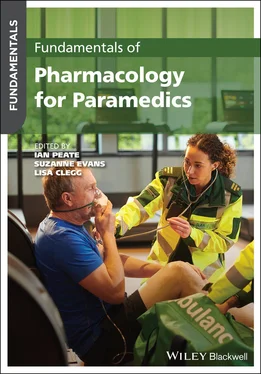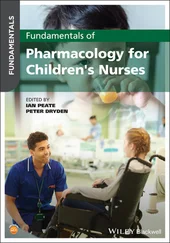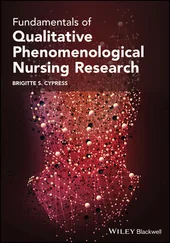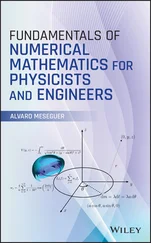1 General Guidance
2 Resuscitation
3 Medical Emergencies
4 Trauma
5 Maternity Care
6 Special Situations
7 Medicines
The approach taken by the Guidelines presents information specific to commonly used drugs and the practical administration of these. In addition, the Guidelines build on this by identifying where a particular drug should fit into the patient’s management plan in a variety of treatment settings (e.g. emergency situations). As such, pertinent information on a particular drug will appear in the Medicines section (section 7) but also in numerous other sections of the book, and successful navigation of this text by paramedics or other clinicians is essential to get the most out of the resource specific to medicines management and clinical application.
It is worth noting that the drugs are presented in alphabetical order in the Medicines section of the Guidelines.
Skills in practice: example of navigating the JRCALC Guidelines
A paramedic looking for information about morphine sulfate will find relevant information about the drug not only in the Medicines section (section 7) but also in other sections specific to other aspects of clinical application such as General Guidance (section 1), Medical Emergencies (section 3) and Trauma (section 4).
General Guidance section (JRCALC Guidelines, section 1)
This section contains a large amount of general information for paramedics covering a broad range of topics including staff health and wellbeing, pain management in adults and children, sexual assault and safeguarding. Each topic has its own chapter within the section. Paramedics can find specific information relating to medicines and their use in clinical practice in the Pain Management for Adults and Children and End of Life Care chapters. It is essential for the paramedic to use the information in these chapters in conjunction with the specific information found in the Medicines section (section 7). Referring only to information on the Medicines pages may result in missing vital information about special applications or clinical situations relating to a specific drug and lead to its incorrect administration in practice.
If administering an analgesic (e.g. morphine) or an opioid antagonist (e.g. naloxone) to a patient at the end of their life, make sure you check the Guidelines in the End of Life Care chapter in the General Guidance section (section 1) as well as the specific drug information contained in the Medicines section (section 7).
The End of Life Care chapter contains more specific medication guidance relating to end‐of‐life care situations and medications may be administered incorrectly if this special guidance is not adhered to.
Resuscitation section (JRCALC Guidelines, section 2)
The Resuscitation section contains information and guidance on a number of topics relating to various aspects of resuscitation. Chapters in this section include out‐of‐hospital cardiac arrest, basic and advanced life support, foreign body airway obstruction, return of spontaneous circulation, death verification, death of a child and tracheostomy and laryngectomy management. In addition to the general guidance for each drug found in section 7, specific information about the drugs used in prehospital cardiac arrest situations can be found in the overview section at the beginning of each chapter within this Resuscitation section. For example, the advanced life support and return of spontaneous circulation chapters contain further information about the use of drugs covered in section 7 but applied to a cardiac arrest situation.
Medical Emergencies section (JRCALC Guidelines, section 3)
This section contains a large amount of specific information relating to a breadth of medical emergencies commonly encountered by paramedics in practice. Section 3 starts with two chapters giving an overview of medical emergencies in adults and children which contain general information relating to medical emergencies and patient assessment (see Table 2.1). The text then focuses on a number of specific aspects of medical emergencies in more detail within which drugs identified in section 7 could be applied.
Each of these chapters is then further split into subsections: an introduction, incidence, severity and outcome, pathophysiology and assessment and management. This provides a comprehensive overview of each medical emergency and how it should be managed by paramedics in practice. Paramedics should refer to this section to see whether a particular drug is used to treat a certain condition and where that drug fits into patient management.
Both hydrocortisone and adrenaline 1:100 have anaphylaxis listed as an indication in their chapters in the Medicines section (section 7). However, the Allergic Reactions Including Anaphylaxis chapter, in the Medical Emergencies section (section 3), should be referred to for more information about where these drugs fit into the management plan for such patients.
Table 2.1 Examples of emergency conditions covered in section 3.
| Acute coronary syndrome |
Hyperventilation syndrome |
| Abdominal pain |
Hypothermia |
| Allergic reactions (including anaphylaxis) |
Implantable cardiovascular defibrillator |
| Altered levels of consciousness |
Management of resuscitation of patients with left ventricular assist devices |
| Asthma in adults and children |
Meningococcal meningitis and septicaemia |
| Cardiac rhythm disturbances |
Mental health presentations |
| Chronic pulmonary disease |
Mental Capacity Act |
| Convulsions in adults |
Respiratory illness in children |
| Convulsions in children |
Sickle cell crisis |
| Dyspnoea |
Sepsis |
| Febrile illness in children |
Stroke/transient ischaemic attack |
| Gastrointestinal bleeding |
Traumatic chest pain |
| Glycaemic emergencies in adults and children |
Overdose and poisoning in adults and children |
| Headache |
Paediatric gastroenteritis |
| Heart failure |
Pulmonary embolism |
| Heat‐related illness |
|
Paramedics need to be aware that just referring to the indications in the Medicines section (section 7) may not give full information about where a drug fits into an ambulance service protocol for management of a certain patient condition, and so the JRCALC guidance in the Medical Emergencies section (section 3) should always be referred to alongside the Medicines section in order to ensure best approach and correct patient management.
Trauma section (JRCALC Guidelines, section 4)
The Trauma section is laid out in a similar structure to the Medical Emergencies section. The initial two chapters give an overview of trauma emergencies in adults and children and the subsequent chapters each contain information about a specific trauma emergency and its paramedic management (see Table 2.2).
All the individual chapters follow a similar format, offering information about the incidence, severity and outcome, pathophysiology and assessment and management of each trauma emergency. In relation to drugs and their use in emergency situations, the Trauma chapter should be used similarly to the Medical Emergencies chapters. Each chapter can be used to find more information about drugs used in the treatment of a given emergency and, more specifically, exactly where a particular drug fits into the treatment and management plan for patients in practice. Paramedics should use this information in conjunction with the Medicines section (section 7) and specific drugs within it, in order to find not only information about when a drug should be used and how it fits into a particular management plan, but also information to ensure the drug is administered correctly, thus reducing the possibility of drug errors.
Читать дальше












